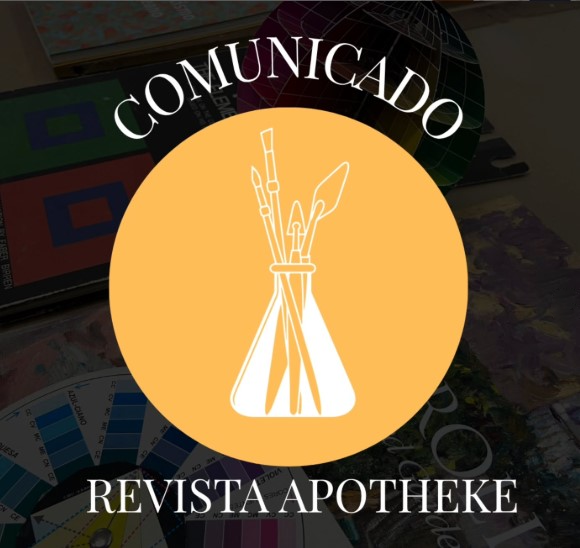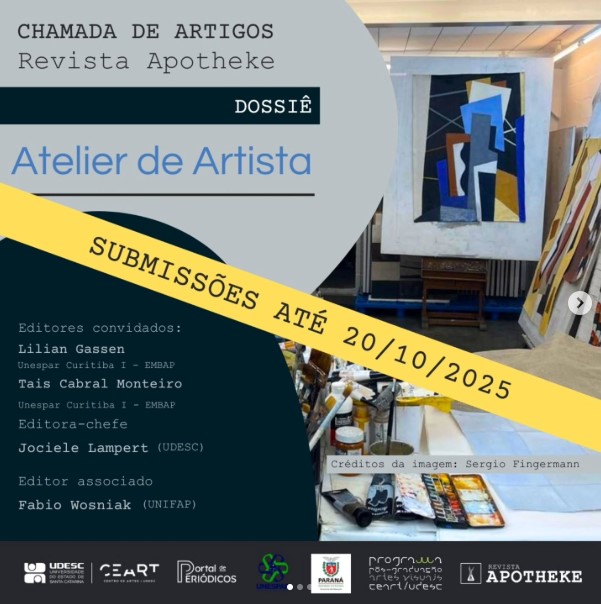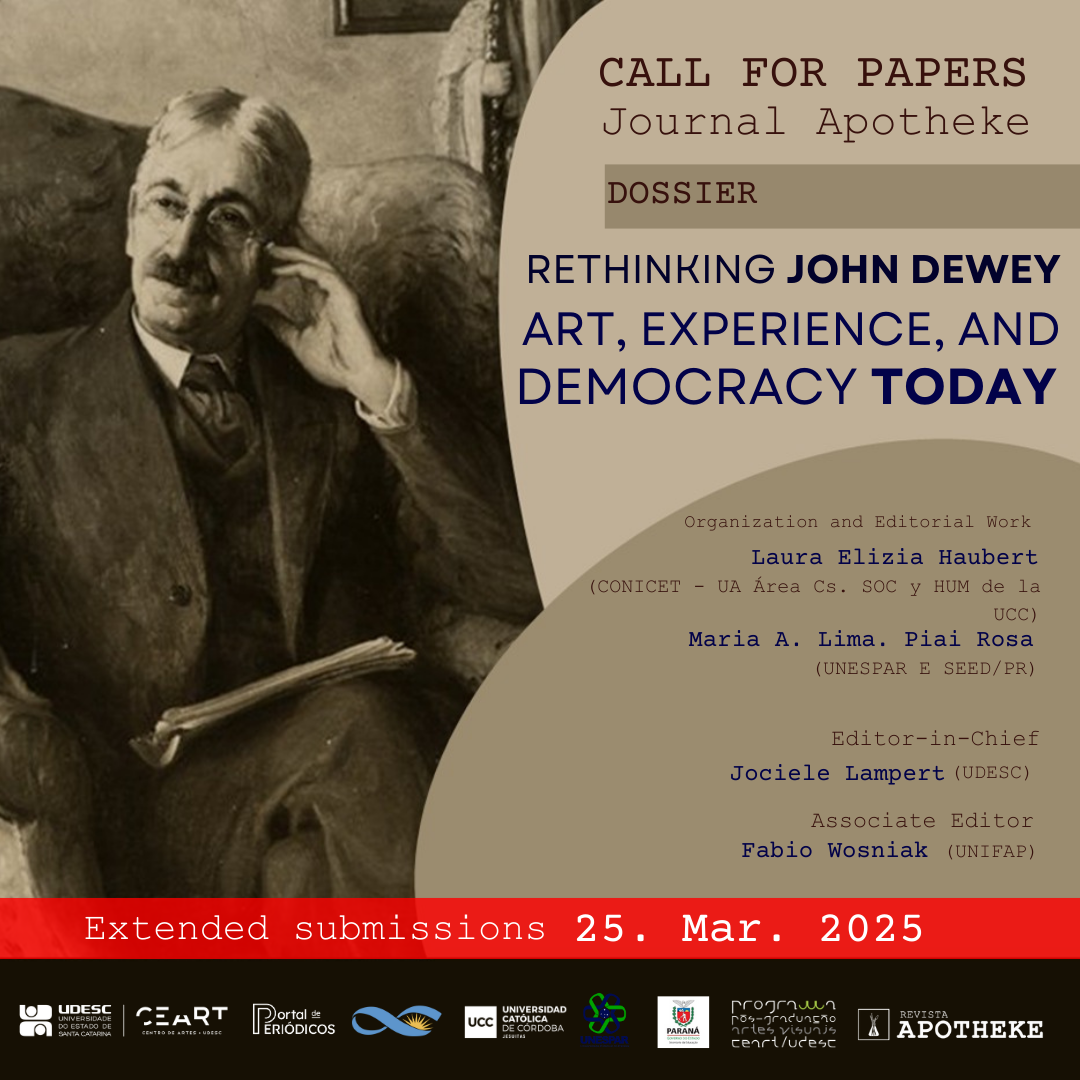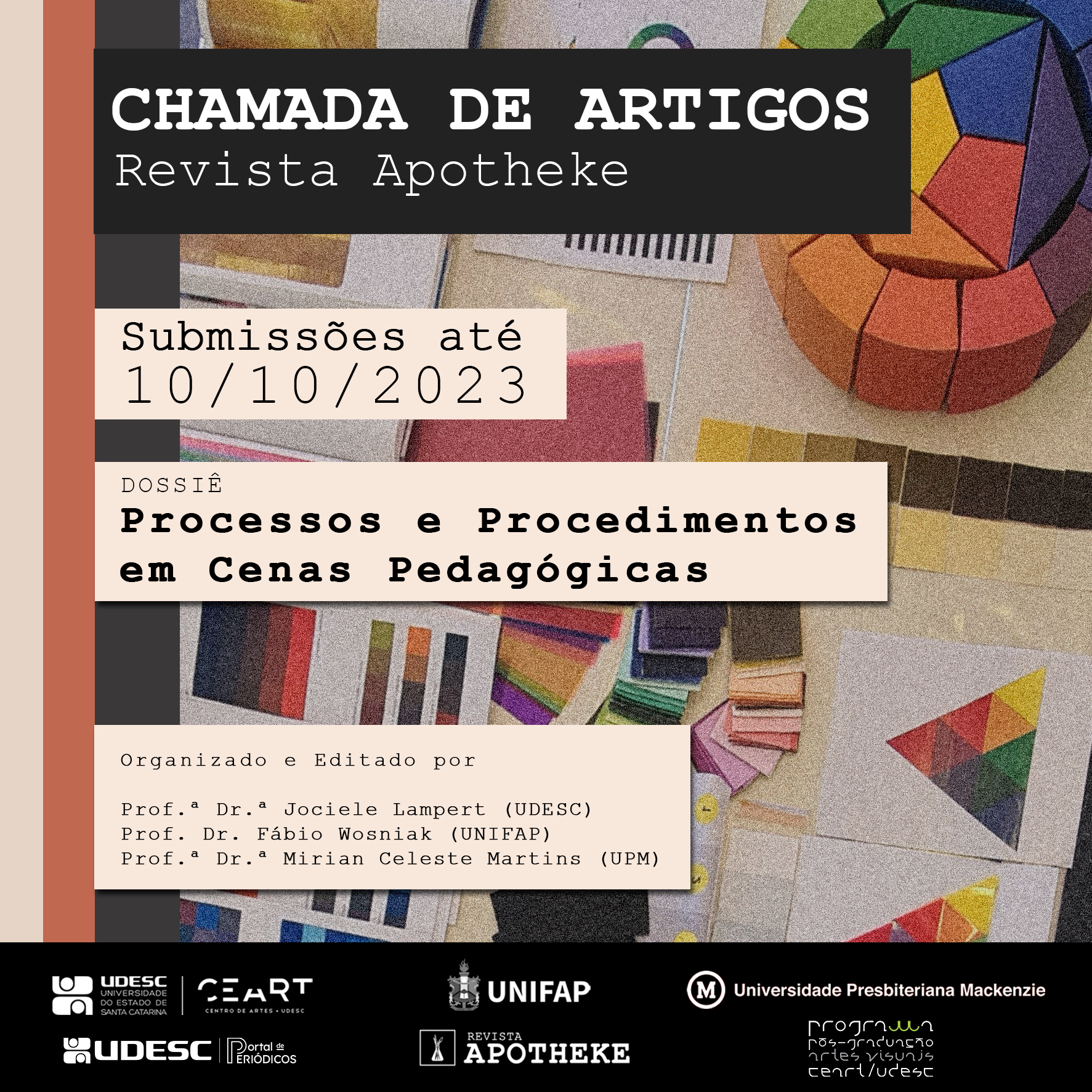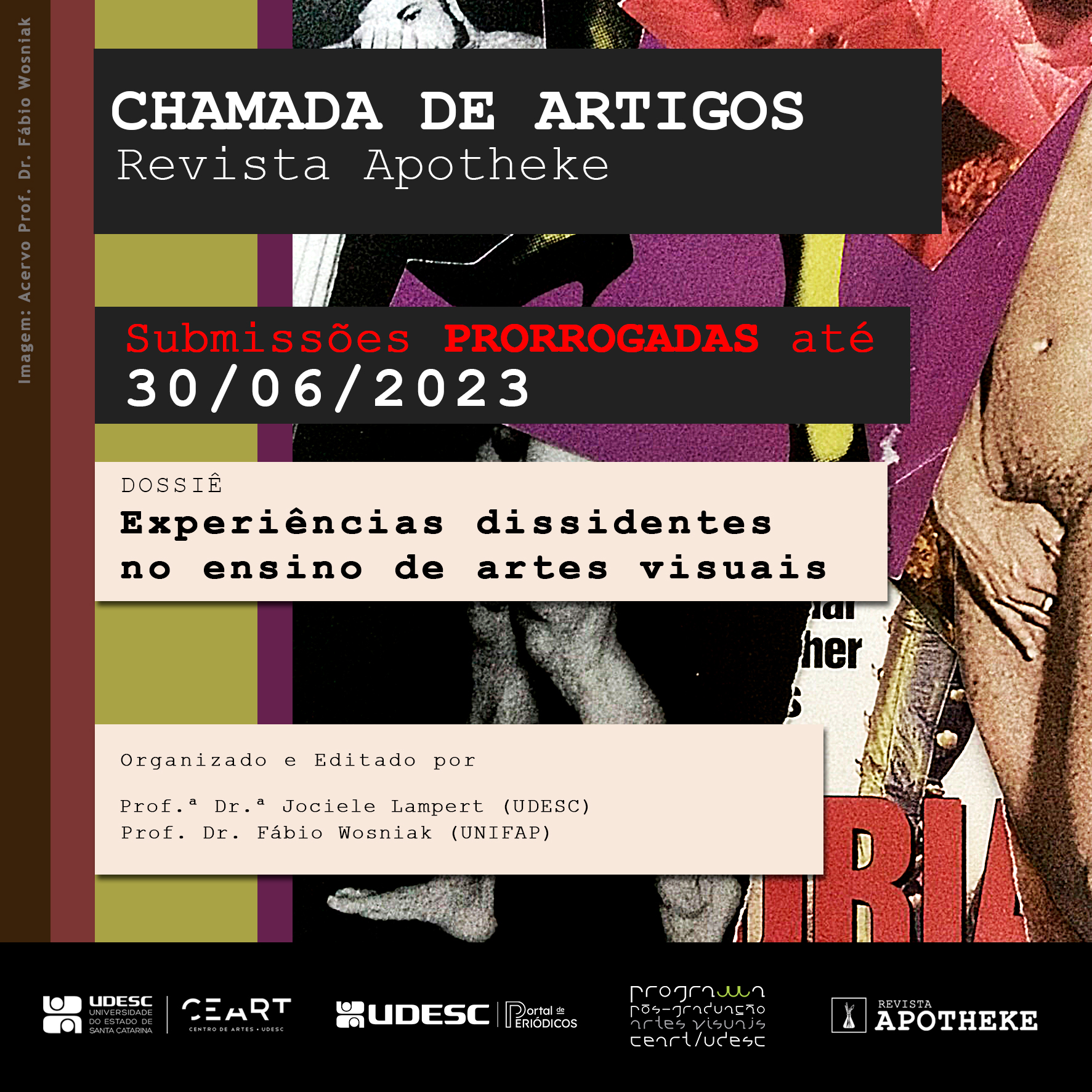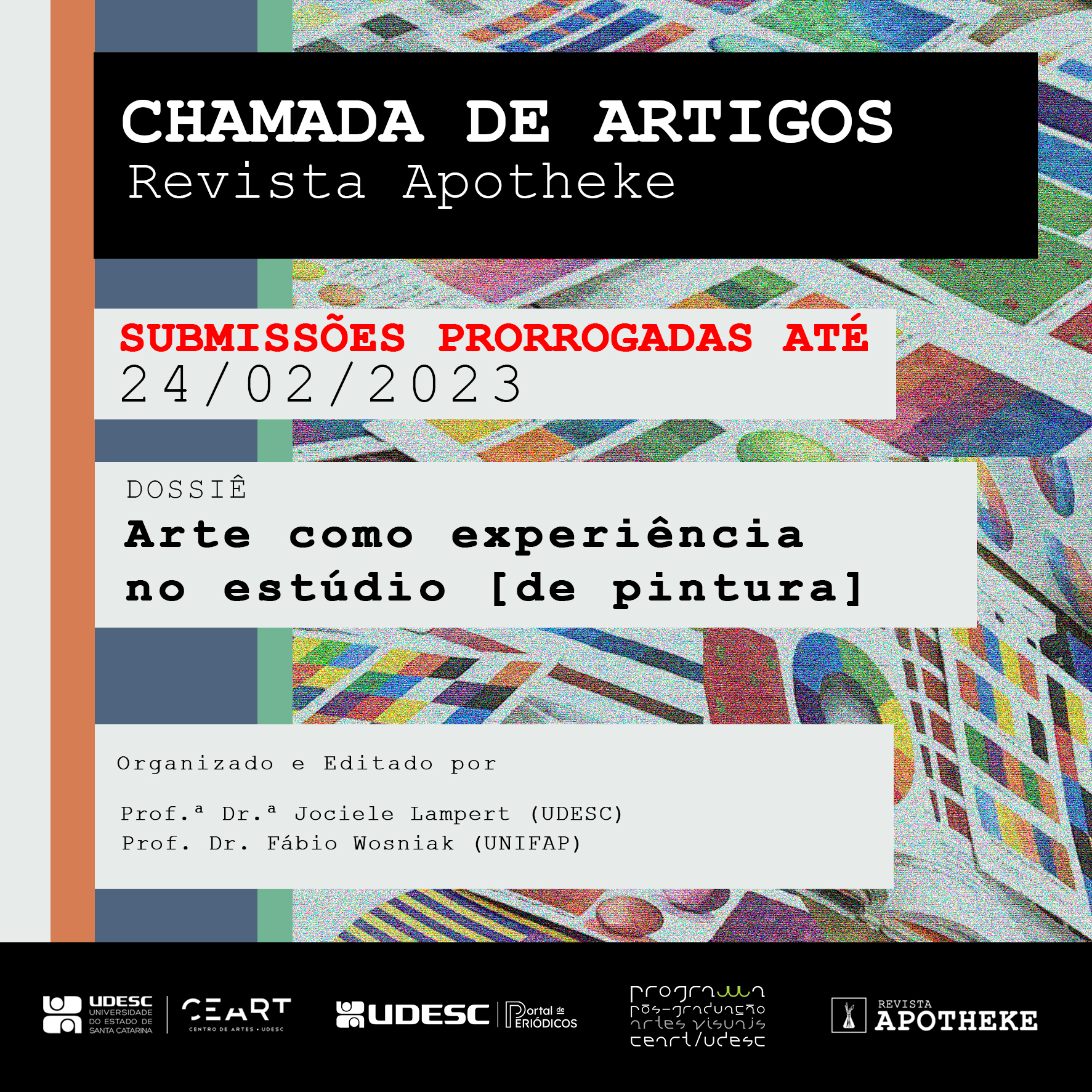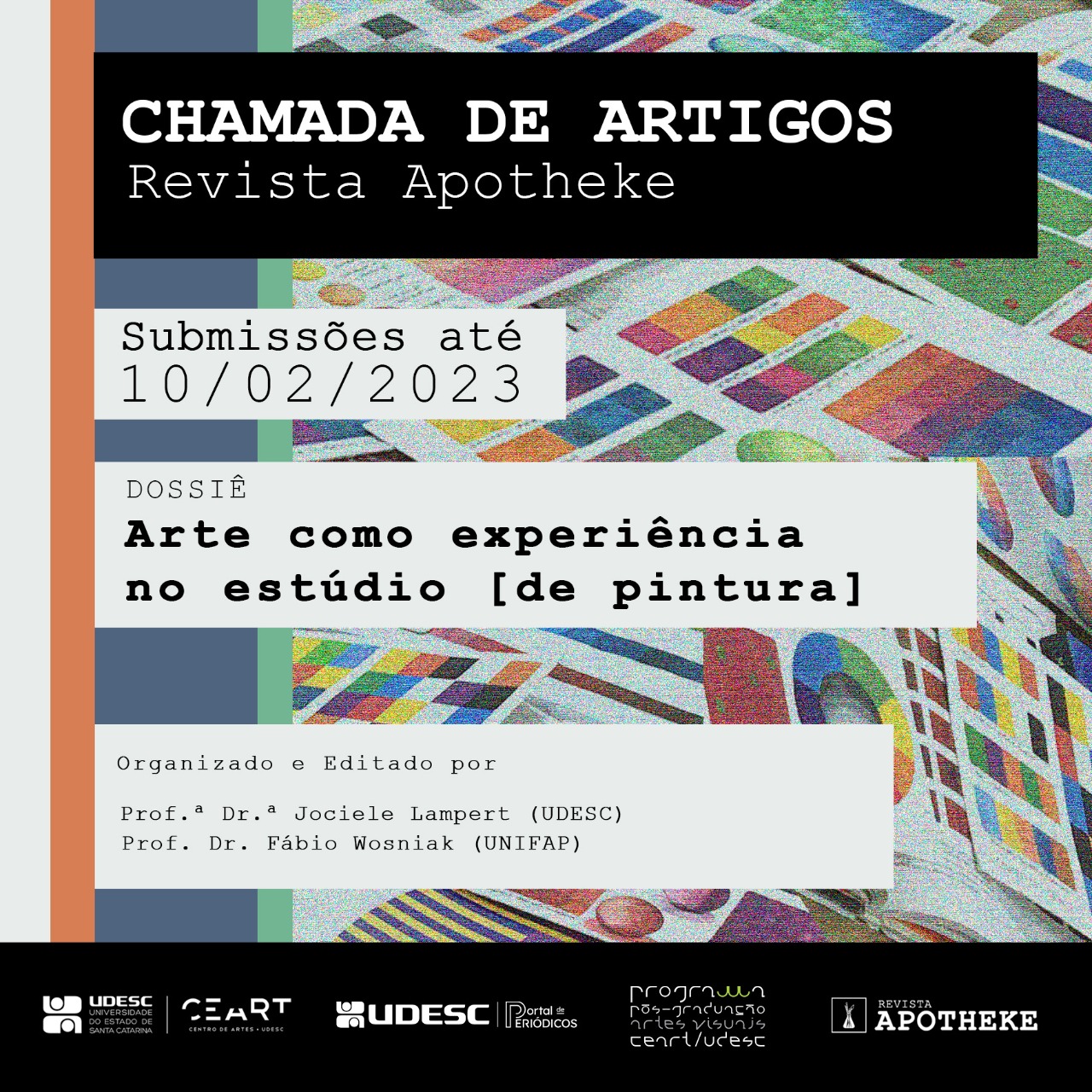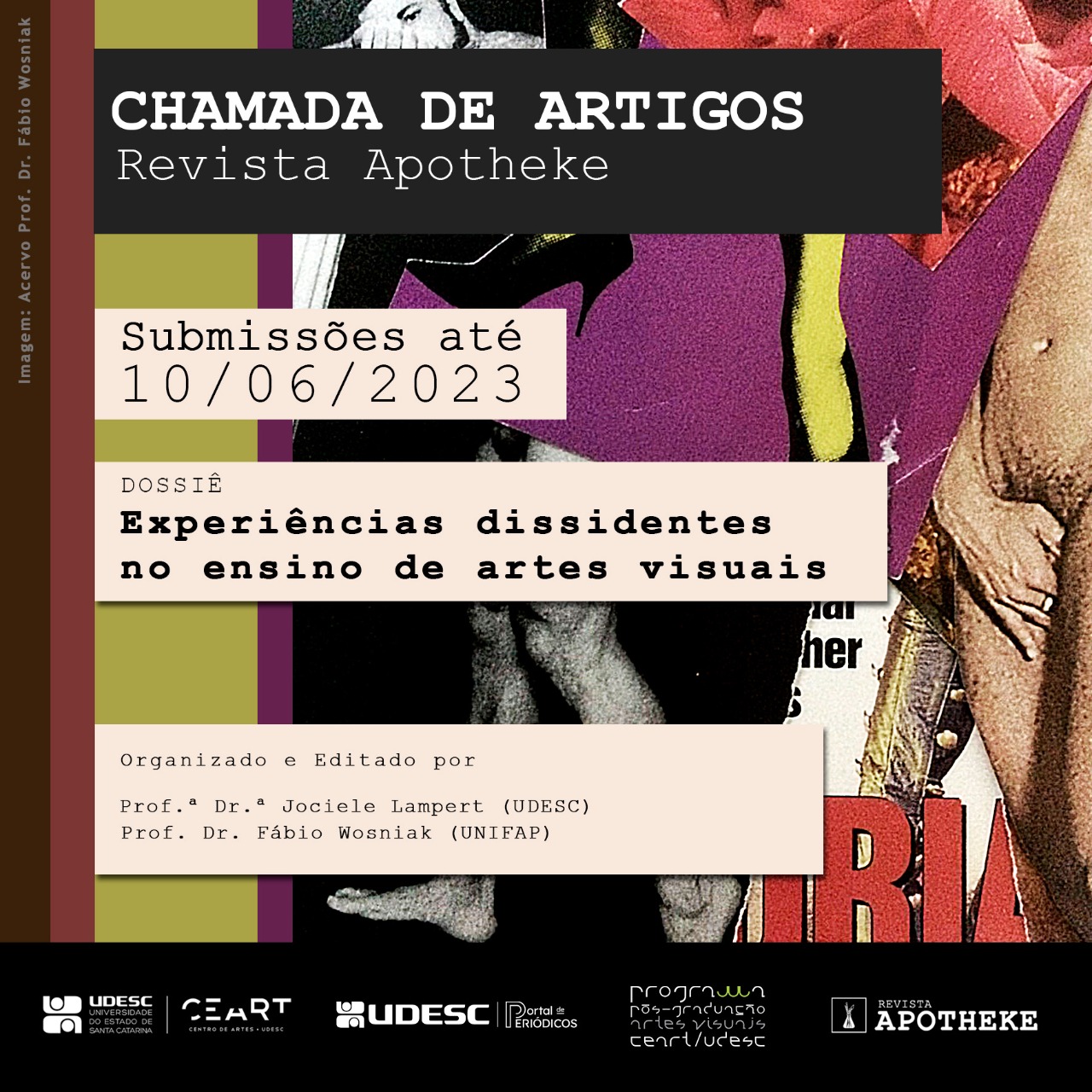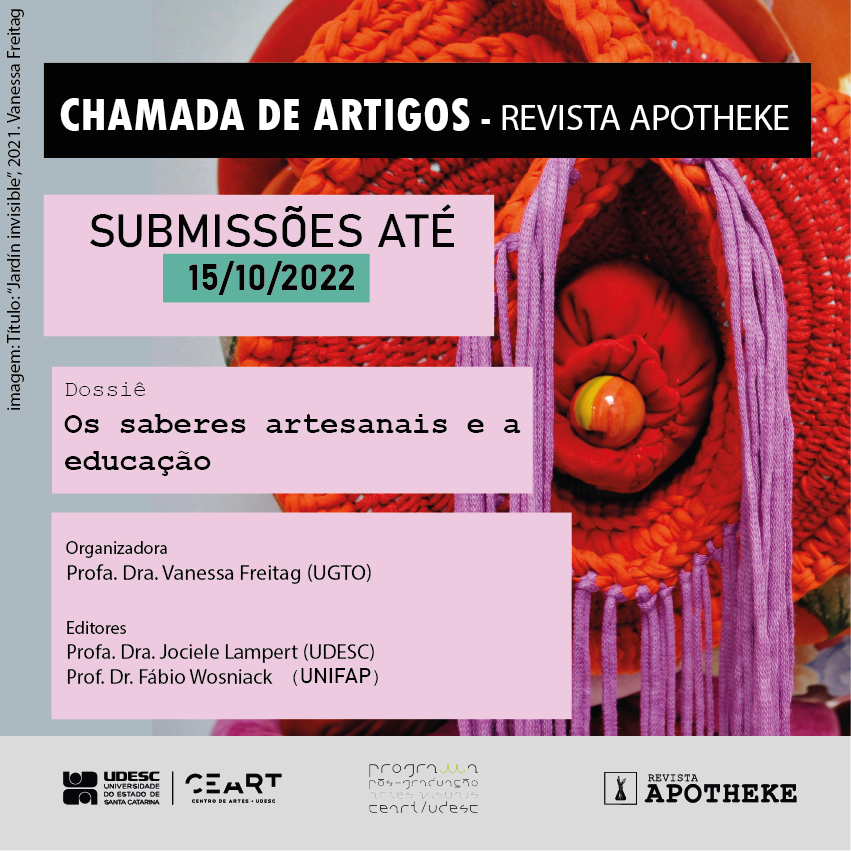Announcements
-
2025-10-11
-
Prorrogação de prazo para submissão de artigos
2025-10-08 -
Call for publication in the Thematic Dossier Artist's Atelier
2025-03-11 -
Call for publication in the Thematic Dossier Educational Turn and its developments in the field of art: critiques, revisions and proposals
2025-03-11 -
Deadline extension for submission of papers
2025-02-26 -
Call for publication in the Thematic Dossier Rethinking John Dewey: Art, Experience and Democracy Nowadays
2025-01-30 -
Chamada de Artigos para o Dossiê Temático Entre abordagens, métodos e metodologias
2024-01-10A Revista Apotheke convida professores/as, artistas, pesquisadores/as, acadêmicos/as e profissionais dedicados às artes visuais para se engajarem ativamente na elaboração dos três volumes que comporão o ano de 2024. Durante este período, nossa revista se empenhará em uma investigação minuciosa do tema central "Entre abordagens, métodos e metodologias", buscando dialogar sobre as múltiplas facetas que permeiam o vasto campo das Artes Visuais em articulação com a Arte/Educação.
Partindo de uma pista dewyana, que propõe que “na arte, assim como na natureza e na vida, as relações são modos de interação”, e que a Arte “deve servir à vida, em vez de prescrever um modo de vida definido e restrito” (DEWEY, 2010, p. 259-260), convocamos os/as colaboradores/as a estabelecerem conexões sigulares entre a prática artística e a prática docente.
Neste contexto, almejamos investigações que reflitam as interseções entre a criação artística e a docência. Como as práticas artísticas podem influenciar e ser influenciadas pela prática pedagógica? Como os/as professores/as podem incorporar inventações docentes e criar metodologias que potencializam tanto a experiência artística quanto o processo de ensino e aprendizagem?
Acreditamos que a reflexão sobre as dinâmicas entre a prática artística e a prática docente pode gerar contribuições significativas para a Arte/Educação. Convidamos, portanto, a submissão de artigos que revelem casos práticos, estudos de caso, experimentações e relatos que evidenciem diálogos frutíferos entre professores, artistas e métodos educativos em artes visuais.
Além disso, incentivamos relatos que promovam uma abordagem integrada entre teoria e prática, conectando os princípios da Arte/Educação às metodologias já existentes e, ao mesmo tempo, propondo atualizações e inovações que atendam às demandas contemporâneas.
Este convite estende-se, igualmente, à análise crítica de metodologias já consolidadas, visando à identificação de possíveis aprimoramentos e adaptações que potencializem o enriquecimento da experiência artística e educativa.
Read more about Chamada de Artigos para o Dossiê Temático Entre abordagens, métodos e metodologias -
Call for publication in the Thematic Dossier Processes and Procedures in Pedagogical Scenes
2023-06-22 -
Deadline extension for article submission
2023-06-13 -
Prorrogação de prazo para submissão de artigos
2023-02-22 -
Call for publication in the Thematic Dossier Art as an experience in the [painting] studio
2022-11-22 -
Call for publication in the Thematic Dossier Dissident experiences in the teaching of visual arts
2022-11-14 -
Call for publication in the Thematic Dossier Craft knowledge and education.
2022-03-15 -
Call for publication in the Thematic Dossier Supervised Internship in Visual Arts: poetics and teaching research
2021-08-27 -
ART AND ITS TEACHING: ARE THEY PATHS FOR EVERYONE?
2021-04-13Who, in a patriarchal society, steps on eggs? And who is respected in the art world? We live in a patriarchal society, consequently excluding, in which cis, trans, black and/or white women, from various social and economic classes are invisibilized. Without disregarding the degrees of erasure, but emphasizing that hegemonic narratives dictate the norms, it is clear that they are produced by and propagated around the white, cis, and almost always Western man. "The man from whom the rib was taken to make the woman", dependent, a part of him, he the owner. It is a founding myth that "authorizes" the man to believe in his superiority over the woman, and he becomes her "owner". It is an origin myth that is repeated, in a Judeo-Christian society, in children's books, in oral narratives, in family behavior between fathers/mothers and sons, in schools, among many other situations; the established norm is that "the man commands and the woman obeys", with the woman always in second place in all social spaces. This does not mean that privileges do not exist, and because of them, fights sometimes flare up. But for those who want a more egalitarian world and who accept the contradictions inherent to the human being, it is necessary to build a society where all schools teach art, where art is the basis of human formation. Let us all be feminists, agreeing with Chimamanda Ngozi Adichie, and learning to cultivate an antiracist, decolonial, and horizontal feminist thought. In effect, we will be walking the paths to build another proposal for a less exclusionary world, a world in which those who produce knowledge and art are no longer valued by the color of their skin or by their gender. That capitalism be questioned and that being has more value than having: this other way of existing is still possible. We hope that in this issue of Apotheke Magazine we have articles that break the barriers of dichotomies, of racisms; that they are centered on self-reflection, on interpersonal collaboration and between knowledges, incorporating in their approaches the criticism against racism, heterosexism and androcentrism; that attempt to emphasize women's empowerment and that are aware of prejudice in relation to gender, race, age, ability, sexuality, class, ethnicity, and other human diversities and dissidences; proposing for a social and worldview change.
Organização: Profa Dra Ana Mae Barbosa (USP/UAM)
Profa Dra Vitória Negreiros do Amaral (PPGAV-UFPE/UFPB
Editores: Profa Dra Jociele Lampert e Prof Dr Fábio Wosniak
Read more about ART AND ITS TEACHING: ARE THEY PATHS FOR EVERYONE? -
Call for publication in the Thematic Dossier Dewey: Education, Visual Arts and Experience
2020-12-08Revista Apotheke will address in this dossier articulations between Education, Visual Arts and Experience, considering the contributions of the American philosopher John Dewey (1859-1952) to the field of Arts, Education and Art Education, including the teaching of visual arts, as well as, performing arts and music. The deweyan theory presented and continues to present a new philosophical project to think about the social conditions and values that involve an idea of knowledge close to the daily experiments of life, where mind and body, life, art and education are not compartments, but are part of of a unity that makes up life. Dewey calls us to think about the union of things, theory/practice, art/life, education/life. Following this assumption, the path of teaching and learning, aimed at critical reflection, the challenge would be to break with the frontier that distinguishes life from other things, that is, to recompose this association would boost the creative power of learning-from-experience.
In this volume of Revista Apotheke, he invites everyone to “think” with Dewey, to learn to learn from his philosophy of experience or experientiality, in which things are not separate from life. The idea of the Dossier is to seek an update of the Deweyan concepts, breaking with the borders and dichotomies, it is an invitation to re-appropriate the philosopher's concepts, without finding definitive answers, but to establish conditions and possibilities for research, where change and creativity are alive.
Read more about Call for publication in the Thematic Dossier Dewey: Education, Visual Arts and Experience -
Outros tons para o debate afro-diaspórico na arte e a fortuna da cor
2020-08-10CHAMADA PARA PUBLICAÇÃO DE ARTIGOS
Prazo limite para envio prorrogado: 15 de março de 2021.
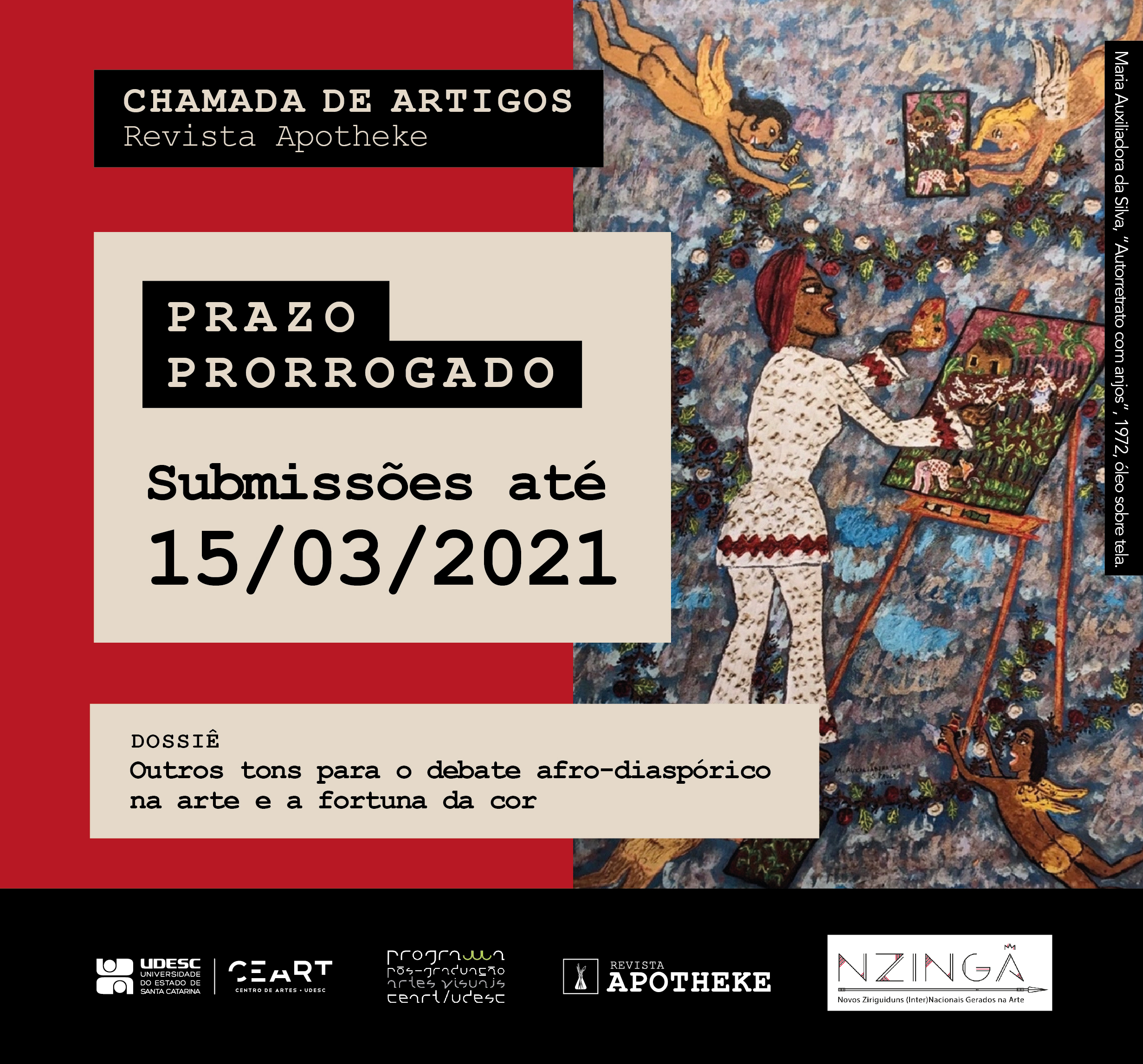

Read more about Outros tons para o debate afro-diaspórico na arte e a fortuna da cor -
Práticas artísticas LGBTI+ para uma educação dissidente
2020-05-28CHAMADA PARA PUBLICAÇÃO DE ARTIGOS
Prazo limite para envio: 20 de outubro 2020.
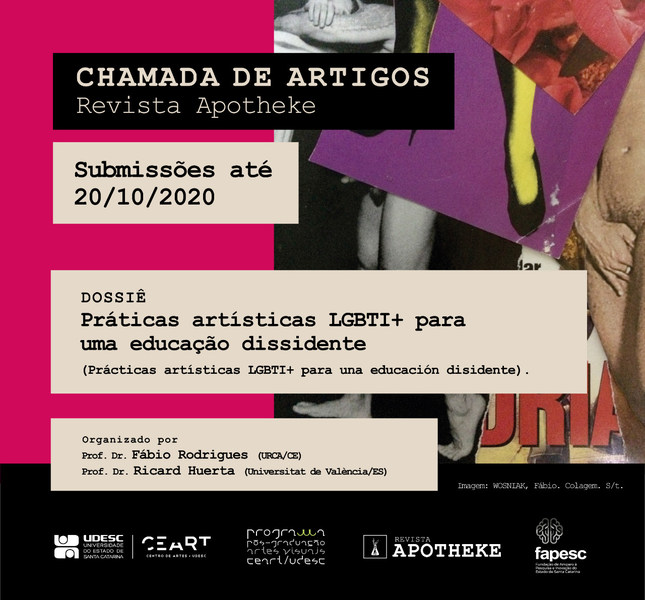
Read more about Práticas artísticas LGBTI+ para uma educação dissidente -
CHAMADA PARA PUBLICAÇÃO DE ARTIGOS
2019-05-14Tema: "O Desenho e o Ensino das Artes Visuais"
Prazo para envio dos trabalhos: 15 julho 2019
Read more about CHAMADA PARA PUBLICAÇÃO DE ARTIGOS -
CHAMADA PARA PUBLICAÇÃO DE ARTIGOS
2019-01-17Tema: “Artista Professor, Professor Artista, sobre ser e estar"
Prazo para envio dos trabalhos: 05 março 2019
Read more about CHAMADA PARA PUBLICAÇÃO DE ARTIGOS -
Chamada para publicação na REVISTA APOTHEKE – Volume 4 n. 3
2018-09-03Tema – Aula Ateliê
Read more about Chamada para publicação na REVISTA APOTHEKE – Volume 4 n. 3
Prazo para envio: 05/11/2018 -
Arte e Cultura Visual
2018-03-03Informamos que a submissão de artigos, para o volume 4, n. 1 - Arte e Cultura Visual, da Revista Apotheke, encontra-se aberta para o segundo quadrimestre de 2018.
Prazo para submissão: até 15/06/2018
Coordenação: Profa. Dra. Aline Nunes (UFRGS)
Read more about Arte e Cultura Visual

